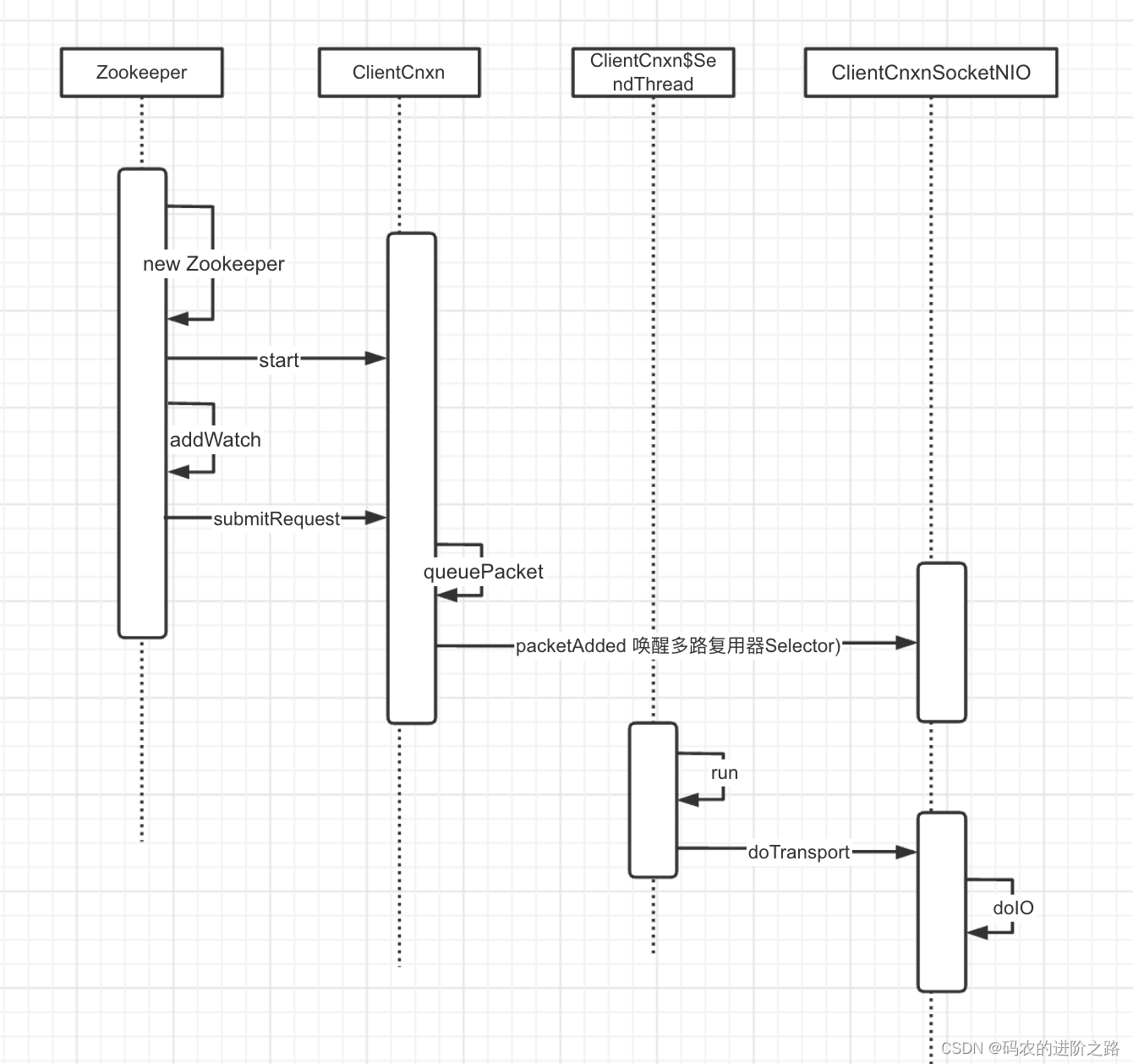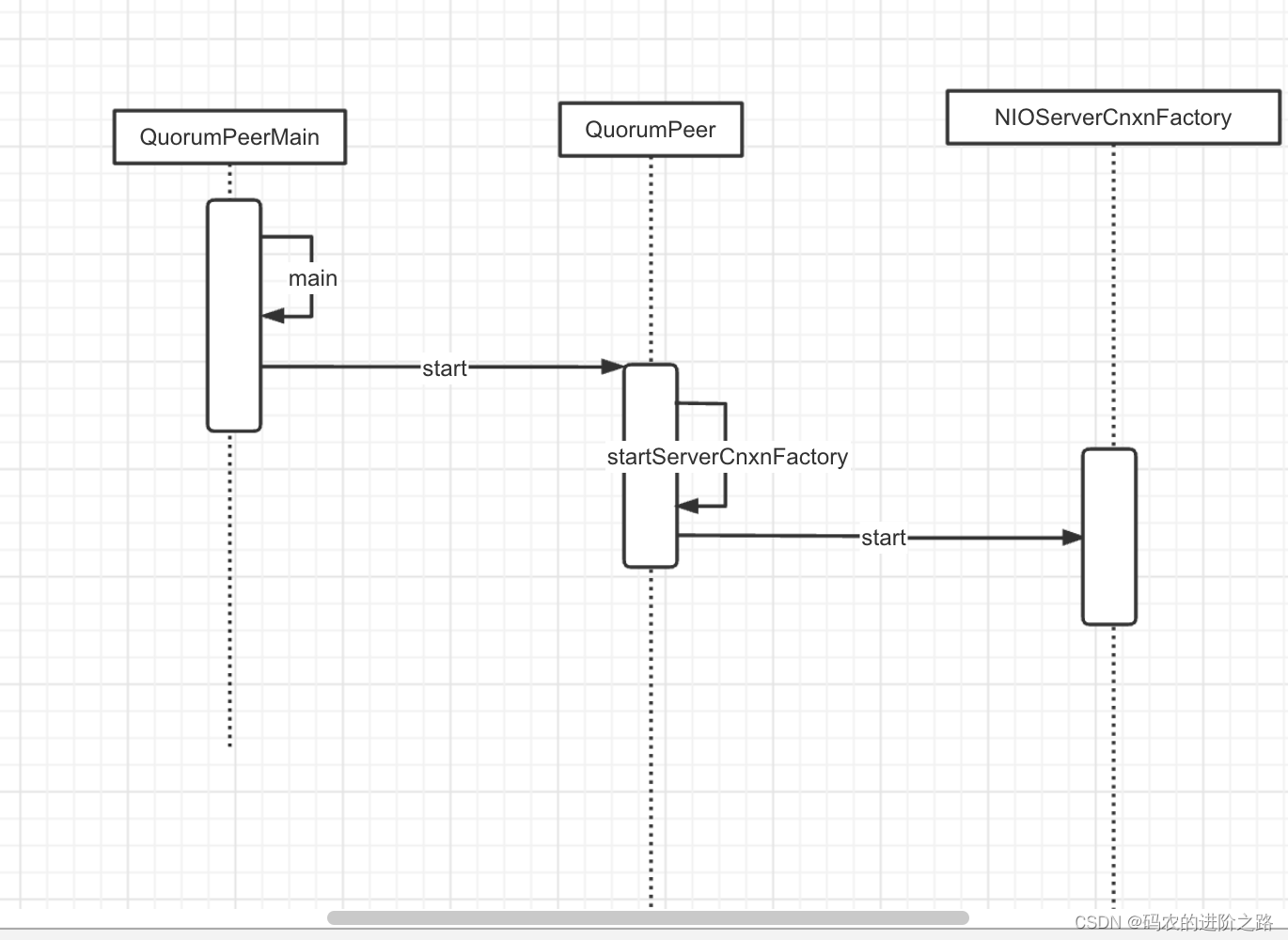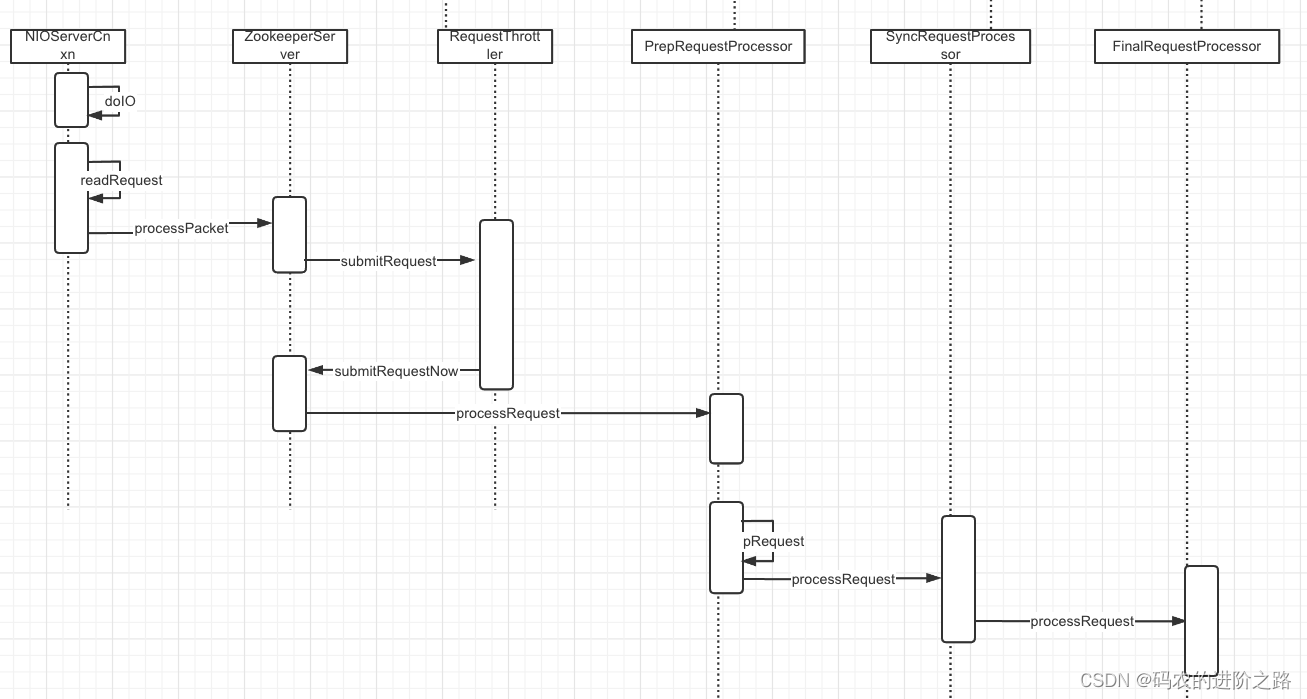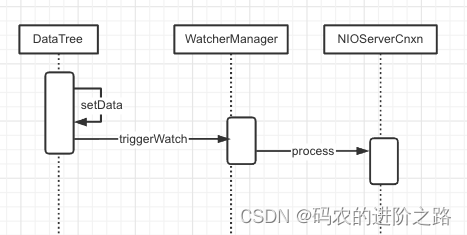zk的watch机制使用及原理分析
Zookeeper引入了wacther机制来实现分布式数据的发布/订阅功能。可以让多个订阅者同时监听某一个主题对象,当主题对象自身状态发生改变时就会通知所有订阅者。以上就是watch注册与实现监听的整个过程了。其实 主体逻辑不复杂,只是夹杂着网络通信以及大量的异步化流程 加大了阅读代码的难度。...
文章目录
Watch机制概述
Zookeeper引入了wacther机制来实现分布式数据的发布/订阅功能。可以让多个订阅者同时监听某一个主题对象,当主题对象自身状态发生改变时就会通知所有订阅者。
Watcher常见的事件类型
| 事件类型 | 事件含义 |
|---|---|
| NodeCreated | 节点被创建 |
| NodeDeleted | 节点被删除 |
| NodeDataChanged | 节点数据发生变化 |
| NodeChildrenChanged | 子节点发生变化(增、删、改) |
Watch机制示例
笔者使用Zookeeper Server 3.6.3版本
<dependency>
<groupId>org.apache.curator</groupId>
<artifactId>curator-framework</artifactId>
<version>5.1.0</version>
</dependency>
<dependency>
<groupId>org.apache.curator</groupId>
<artifactId>curator-recipes</artifactId>
<version>5.1.0</version>
</dependency>
public class WatchDemo {
public static void main(String[] args) throws Exception {
CountDownLatch countDownLatch = new CountDownLatch(1);
ZooKeeper zooKeeper = new ZooKeeper("127.0.0.1:2181", 30000, watchedEvent -> {
if (watchedEvent.getState().equals(Watcher.Event.KeeperState.SyncConnected)) {
System.out.println("连接zk成功");
countDownLatch.countDown();
}
});
countDownLatch.await();
zooKeeper.exists("/exist", new MyWatcher2(zooKeeper));
Stat stat = new Stat();
zooKeeper.getData("/data", new MyWatcher(), stat);
zooKeeper.getChildren("/child", new MyWatcher());
zooKeeper.addWatch("/wojiushiwo", watchedEvent -> {
System.out.println("--------" + watchedEvent.getPath() + "持久化监听--------");
}, AddWatchMode.PERSISTENT);
zooKeeper.addWatch("/test", watchedEvent -> {
System.out.println("--------" + watchedEvent.getPath() + "持久化递归监听--------");
}, AddWatchMode.PERSISTENT_RECURSIVE);
System.in.read();
}
static class MyWatcher implements Watcher {
@Override
public void process(WatchedEvent watchedEvent) {
System.out.println("--------" + watchedEvent.getPath() + "接收监听--------");
}
}
static class MyWatcher2 implements Watcher {
ZooKeeper zooKeeper;
public MyWatcher2(ZooKeeper zooKeeper) {
this.zooKeeper = zooKeeper;
}
@Override
public void process(WatchedEvent watchedEvent) {
System.out.println("--------" + watchedEvent.getPath() + "接收监听--------");
try {
//回调中 再次注册监听
zooKeeper.exists(watchedEvent.getPath(),this);
} catch (KeeperException e) {
e.printStackTrace();
} catch (InterruptedException e) {
e.printStackTrace();
}
}
}
}
示例中给出了数种wacth监听方式的使用。其中,getData、exists、getChildren是较旧的监听API,默认均是一次性监听,监听被出发后即被删除。因此想要多次监听 则必须在watch回调中手动再次注册监听,如上面的MyWatcher2#process
zk另外新增了一个添加监听的API:addWatch,它可以实现持久化监听,其AddWatchMode值类型如下:
- PERSISTENT 持久化监听
- PERSISTENT_RECURSIVE 持久化递归监听 可以监听子节点的变化
Watch机制流程浅析
Watch注册流程
以addWatch持久化监听为例简述下Watch的注册过程
-
客户端将watch请求 封装为Packet,将Packet放到阻塞队列outgoingQueue中;随后在异步流程中,将Packet序列化后由网络通信发送至服务器端
-
服务器端读取客户端的注册watch请求,将path与watcher的关联关系写入到服务端维护的两个HashMap中。随后 向客户端进行响应
//一个path路径下可能有多个Watcher,这里的Watcher实际上是NIOServerCnxn
private final Map<String, Set<Watcher>> watchTable = new HashMap<>();
//一个Watcher可能被多个path路径复用,这里的Watcher实际上是NIOServerCnxn
private final Map<Watcher, Set<String>> watch2Paths = new HashMap<>();
-
客户端收到服务器端的响应后,也将path与watcher监听器的关联关系写入到客户端维护的HashMap中
private final Map<String, Set<Watcher>> persistentWatches = new HashMap<String, Set<Watcher>>();
Watch通知流程
- 服务器端响应客户端对某path的操作,如果该path恰好被监听,那么会根据path-watcher的关系 找到监听该path的所有watcher进行通知,随后服务器端将watcher通知 响应给客户端
- 客户端收到服务器端的watch通知后,会根据path找到相应的客户端wacther 进行回调通知
说白了 就是 客户端和服务端分别维护自己的监听路径与wacther的关联。客户端对znode的某些特定操作下 会触发服务器端的监听机制,服务端将对应的path推给客户端由客户端发起监听回调。只是当中穿插着网络通信以及大量的异步流程 使得整个流程显得不那么清晰明朗了。
源码浅析
Watch注册过程分析
下面我们从源码出发 先来分析下Watch注册的主要流程
客户端发送请求
客户端发送请求的时序图

先来看下Zookeeper对象的构造,其构造方法内部包含了对几个重要对象的创建以及线程的启动,它们在watch的注册很重要
Zookeeper
public ZooKeeper(
String connectString,
int sessionTimeout,
Watcher watcher,
boolean canBeReadOnly,
HostProvider aHostProvider,
ZKClientConfig clientConfig) throws IOException {
//省略日志
if (clientConfig == null) {
clientConfig = new ZKClientConfig();
}
this.clientConfig = clientConfig;
//ZKWatchManager
watchManager = defaultWatchManager();
watchManager.defaultWatcher = watcher;
ConnectStringParser connectStringParser = new ConnectStringParser(connectString);
hostProvider = aHostProvider;
//创建客户端连接 得到的是ClientCnxn
cnxn = createConnection(
connectStringParser.getChrootPath(),
hostProvider,
sessionTimeout,
this,
watchManager,
//创建得到的是ClientCnxnSocketNIO
getClientCnxnSocket(),
canBeReadOnly);
//启动ClientCnxn
cnxn.start();
}
ClientCnxn
它是客户端负责网络通信的类,它内部有两个线程很重要
- SendThread 负责客户端发起请求 以及 接收服务端的响应
- EventThread 负责处理watch事件
public void start() {
//启动发送线程 该线程主要处理涉及服务端通信的读写操作
sendThread.start();
//启动事件线程
eventThread.start();
}
介绍完前置内容后,下面正式从addWatch方法开始展开
Zookeeper
//basePath 监听的节点路径
//watcher 监听器对象
//监听模式:有持久化监听、有持久化递归监听
public void addWatch(String basePath, Watcher watcher, AddWatchMode mode)
throws KeeperException, InterruptedException {
//省略无关代码
//请求头对象
RequestHeader h = new RequestHeader();
//请求头类型 服务端接收到请求后 会根据type执行不同逻辑
h.setType(ZooDefs.OpCode.addWatch);
//请求对象
AddWatchRequest request = new AddWatchRequest(serverPath, mode.getMode());
//提交请求(结合上下文 cnxn这里是ClientCnxnSocketNIO)
ReplyHeader r = cnxn.submitRequest(h, request, new ErrorResponse(),
new AddWatchRegistration(watcher, basePath, mode));
//如果响应出错 抛出异常
if (r.getErr() != 0) {
throw KeeperException.create(KeeperException.Code.get(r.getErr()),
basePath);
}
}
ClientCnxn
public ReplyHeader submitRequest(
RequestHeader h,
Record request,
Record response,
WatchRegistration watchRegistration,
WatchDeregistration watchDeregistration) throws InterruptedException {
ReplyHeader r = new ReplyHeader();
//构造packet对象 并将其加入到outgoingQueue队列
Packet packet = queuePacket(
h,
r,
request,
response,
null,
null,
null,
null,
watchRegistration,
watchDeregistration);
//阻塞方式获得pakcet
synchronized (packet) {
if (requestTimeout > 0) {
// Wait for request completion with timeout
waitForPacketFinish(r, packet);
} else {
// Wait for request completion infinitely
while (!packet.finished) {
packet.wait();
}
}
}
if (r.getErr() == Code.REQUESTTIMEOUT.intValue()) {
sendThread.cleanAndNotifyState();
}
return r;
}
眼见的读者会发现,提交完请求之后就返回了,什么逻辑都没有了,那程序接下来是怎么执行的呢?
别着急,既然同步流程执行结束了,那会不会有异步流程呢?毕竟packet是被加入到阻塞队列的,肯定有一处代码 会将packet从队列取出来的。
还记得我们前面提过的SendThread线程吗?没错 接下来就从这个线程出发 继续探索watch执行踪迹
SendThread
//SendThread 构造函数
SendThread(ClientCnxnSocket clientCnxnSocket) {
super(makeThreadName("-SendThread()"));
state = States.CONNECTING;
//ClientCnxnSocketNIO
this.clientCnxnSocket = clientCnxnSocket;
//守护线程
setDaemon(true);
}
//SendThread线程执行逻辑
public void run() {
clientCnxnSocket.introduce(this, sessionId, outgoingQueue);
clientCnxnSocket.updateNow();
clientCnxnSocket.updateLastSendAndHeard();
int to;
long lastPingRwServer = Time.currentElapsedTime();
final int MAX_SEND_PING_INTERVAL = 10000; //10 seconds
InetSocketAddress serverAddress = null;
while (state.isAlive()) {
//省略无关代码
//主要逻辑是基于NIO来实现请求的发送与接收
clientCnxnSocket.doTransport(to, pendingQueue, ClientCnxn.this);
//省略无关代码
}
ClientCnxnSocketNIO
//下面的代码比较多,但大多是NIO的模版代码 我们注重看下对读写请求的操作
void doTransport(
int waitTimeOut,
Queue<Packet> pendingQueue,
ClientCnxn cnxn) throws IOException, InterruptedException {
//等待接收链接
selector.select(waitTimeOut);
Set<SelectionKey> selected;
synchronized (this) {
selected = selector.selectedKeys();
}
updateNow();
for (SelectionKey k : selected) {
SocketChannel sc = ((SocketChannel) k.channel());
//省略无关代码
} else if ((k.readyOps() & (SelectionKey.OP_READ | SelectionKey.OP_WRITE)) != 0) {
//如果是读或写操作 则执行这里
doIO(pendingQueue, cnxn);
}
}
//省略无关代码
selected.clear();
}
void doIO(Queue<Packet> pendingQueue, ClientCnxn cnxn) throws InterruptedException, IOException {
SocketChannel sock = (SocketChannel) sockKey.channel();
if (sock == null) {
throw new IOException("Socket is null!");
}
//读操作 此时客户端是写请求 因此略过这里
if (sockKey.isReadable()) {
//...
}
//如果是写操作
if (sockKey.isWritable()) {
//看到这里终于找到了outgoingQueue了,没错这里就是从outgoingQueue中取出packet
Packet p = findSendablePacket(outgoingQueue, sendThread.tunnelAuthInProgress());
if (p != null) {
updateLastSend();
// If we already started writing p, p.bb will already exist
if (p.bb == null) {
if ((p.requestHeader != null)
&& (p.requestHeader.getType() != OpCode.ping)
&& (p.requestHeader.getType() != OpCode.auth)) {
//设置Xid
p.requestHeader.setXid(cnxn.getXid());
}
//数据序列化 便于网络传输
p.createBB();
}
//将序列化后的数据 发送给服务端
sock.write(p.bb);
//省略无关代码
}
至此 客户端就将watch监听的请求发送出去了,接下来我们看下服务端是怎么做的?
服务端接收请求
老规矩,为了好理解下面的代码 因此将服务端这块逻辑涉及的几个重要类的初始化先拎出来说下

由上面时序图可以看出,在zk启动时便会初始化及启动NIOServerCnxnFactory,其主要代码如下
//QuorumPeerMain#main
if (config.getClientPortAddress() != null) {
//默认实现类NIOServerCnxnFactory
cnxnFactory = ServerCnxnFactory.createFactory();
cnxnFactory.configure(config.getClientPortAddress(), config.getMaxClientCnxns(), config.getClientPortListenBacklog(), false);
}
NIOServerCnxnFactory
public void start() {
stopped = false;
if (workerPool == null) {
//创建线程池 后面会用来执行任务
workerPool = new WorkerService("NIOWorker", numWorkerThreads, false);
}
//启动SelectorThread
for (SelectorThread thread : selectorThreads) {
if (thread.getState() == Thread.State.NEW) {
thread.start();
}
}
//启动acceptThread
if (acceptThread.getState() == Thread.State.NEW) {
acceptThread.start();
}
//启动expirerThread
if (expirerThread.getState() == Thread.State.NEW) {
expirerThread.start();
}
}
这里来说下,NIOServerCnxnFactory将接收网络连接与处理IO的操作分开了,也即是AcceptThread用来接收连接,SelectorThread用来处理IO请求。

上面的流程中SelectorThread接收到客户端请求,然后交由线程池处理调度。循着这个调用链路 我们直接从NIOServerCnxn#doIO开始看下后续的调用时序图

NIOServerCnxn
void doIO(SelectionKey k) throws InterruptedException {
try {
//省略无关代码
//处理客户端写请求
if (k.isReadable()) {
int rc = sock.read(incomingBuffer);
if (rc < 0) {
handleFailedRead();
}
if (incomingBuffer.remaining() == 0) {
boolean isPayload;
省略无关代码
if (isPayload) {
//读取数据
readPayload();
} else {
return;
}
}
}
//省略无关代码
}
小插曲
zk大量使用了阻塞队列与异步线程,因此当主流程走不通时 看看有没有异步线程存在,会不会逻辑在异步线程中被执行
言归正传,
时序图中PrepRequestProcessor、SyncRequestProcessor、FinalRequestProcessor是责任链机制,责任链构造代码如下
protected void setupRequestProcessors() {
RequestProcessor finalProcessor = new FinalRequestProcessor(this);
RequestProcessor syncProcessor = new SyncRequestProcessor(this, finalProcessor);
((SyncRequestProcessor) syncProcessor).start();
firstProcessor = new PrepRequestProcessor(this, syncProcessor);
((PrepRequestProcessor) firstProcessor).start();
}
并且PrepRequestProcessor、SyncRequestProcessor、FinalRequestProcessor均是线程类,结合着阻塞队列 完成异步任务。在当前流程下PrepRequestProcessor、SyncRequestProcessor没做什么事,我们直接看FinalRequestProcessor了
FinalRequestProcessor
public void processRequest(Request request) {
//省略无关代码
switch (request.type) {
//省略无关代码 因为客户端发送请求类型是addWatch 因此直接定位到这里
case OpCode.addWatch: {
lastOp = "ADDW";
AddWatchRequest addWatcherRequest = new AddWatchRequest();
ByteBufferInputStream.byteBuffer2Record(request.request,
addWatcherRequest);
//存储watch关联关系
zks.getZKDatabase().addWatch(addWatcherRequest.getPath(), cnxn, addWatcherRequest.getMode());
rsp = new ErrorResponse(0);
break;
}
//省略无关代码
ReplyHeader hdr = new ReplyHeader(request.cxid, lastZxid, err.intValue());
//省略无关代码
//发送服务端添加watch的响应给客户端
cnxn.sendResponse(hdr, rsp, "response");
}
}
//省略无关代码
}
终于来到了服务端存储watch关系的地方了,下面画出addWatch的时序图 并进行分析

WatchManager
private final Map<String, Set<Watcher>> watchTable = new HashMap<>();
private final Map<Watcher, Set<String>> watch2Paths = new HashMap<>();
public synchronized boolean addWatch(String path, Watcher watcher, WatcherMode watcherMode) {
//省略无关代码
//查找当前路径下的watcher
Set<Watcher> list = watchTable.get(path);
if (list == null) {
//若不存在 则构建watchTable
list = new HashSet<>(4);
watchTable.put(path, list);
}
//将watcher添加到进去 这里的watcher不是客户端自定义的 是NIOServerCnxn
list.add(watcher);
//同理 维护Watcher与path的关系
Set<String> paths = watch2Paths.get(watcher);
if (paths == null) {
// cnxns typically have many watches, so use default cap here
paths = new HashSet<>();
watch2Paths.put(watcher, paths);
}
//设置 监听模式
watcherModeManager.setWatcherMode(watcher, path, watcherMode);
return paths.add(path);
}
服务端添加过watcher之后 会向客户端发起响应,这里的网络通信就不分析了。
客户端接收服务端的addWatch响应

上图 给出了 接收到服务端请求后客户端的注册过程
private final Map<String, Set<Watcher>> persistentWatches = new HashMap<String, Set<Watcher>>();
public void register(int rc) {
if (shouldAddWatch(rc)) {
//我们基于addWatch添加的监听 因此其实现类是AddWatchRegistration
//这里会根据监听模式的不同 而选择不同的Map来存储
Map<String, Set<Watcher>> watches = getWatches(rc);
synchronized (watches) {
Set<Watcher> watchers = watches.get(clientPath);
if (watchers == null) {
watchers = new HashSet<Watcher>();
watches.put(clientPath, watchers);
}
}
//这里的watcher 是客户端定义的
watchers.add(watcher);
}
}
至此 客户端、服务端添加watch的流程就分析完了,下面我们分析下watch机制是如何被触发的?
Watch通知过程分析
我们知道,客户端只是发送请求 而真正处理逻辑的地方在服务端,那么可以推测watch通知是由服务端通知到客户端的。
结合前面的示例,假如我们对/wojiushiwo 这个path进行了监听,那当我们操作set /wojiushwo 1234时 会发生什么呢?
当客户端对znode的某些操作 会触发watche机制,假如客户端执行的是 set path value指令,我们看下服务端是怎么处理的?
有了前面的基础 我们直接来到FinalRequestProcessor

根据时序图 直接来到DataTree,看看服务端对set指令做了什么操作?
DataTree
public ProcessTxnResult processTxn(TxnHeader header, Record txn, boolean isSubTxn) {
ProcessTxnResult rc = new ProcessTxnResult();
try {
//从客户端请求中 取出数据
rc.clientId = header.getClientId();
rc.cxid = header.getCxid();
rc.zxid = header.getZxid();
rc.type = header.getType();
rc.err = 0;
rc.multiResult = null;
switch (header.getType()) {
//省略无关代码
case OpCode.setData:
SetDataTxn setDataTxn = (SetDataTxn) txn;
rc.path = setDataTxn.getPath();
rc.stat = setData(
setDataTxn.getPath(),
setDataTxn.getData(),
setDataTxn.getVersion(),
header.getZxid(),
header.getTime());
break;
//省略无关代码
return rc;
}
接着看setData的执行时序

通过时序图发现,setData中有对watcher进行触发的动作
WatcherManager
//path 节点路径
//type 节点事件类型,结合我们的举例 这里type=NodeDataChanged
public WatcherOrBitSet triggerWatch(String path, EventType type, WatcherOrBitSet supress) {
// 构造WatchedEvent
WatchedEvent e = new WatchedEvent(type, KeeperState.SyncConnected, path);
Set<Watcher> watchers = new HashSet<>();
PathParentIterator pathParentIterator = getPathParentIterator(path);
synchronized (this) {
for (String localPath : pathParentIterator.asIterable()) {
//取出localPath关联的watcher
Set<Watcher> thisWatchers = watchTable.get(localPath);
//没有设置监听 则跳过
if (thisWatchers == null || thisWatchers.isEmpty()) {
continue;
}
Iterator<Watcher> iterator = thisWatchers.iterator();
// 迭代wacther
while (iterator.hasNext()) {
Watcher watcher = iterator.next();
//获取监听类型
WatcherMode watcherMode = watcherModeManager.getWatcherMode(watcher, localPath);
//如果是递归监听
if (watcherMode.isRecursive()) {
if (type != EventType.NodeChildrenChanged) {
watchers.add(watcher);
}
} else if (!pathParentIterator.atParentPath()) {
watchers.add(watcher);
//看这里 如果不是持久化监听 则删除监听器
if (!watcherMode.isPersistent()) {
iterator.remove();
Set<String> paths = watch2Paths.get(watcher);
if (paths != null) {
paths.remove(localPath);
}
}
}
}
if (thisWatchers.isEmpty()) {
watchTable.remove(localPath);
}
}
}
if (watchers.isEmpty()) {
//省略日志
return null;
}
//逐个执行wacther,这里的Watcher类型是NioServerCnxn
for (Watcher w : watchers) {
if (supress != null && supress.contains(w)) {
continue;
}
//这里才是响应客户端的关键
w.process(e);
}
//省略无关代码
return new WatcherOrBitSet(watchers);
}
这里 留意下,当监听模式不是持久化监听时,会删除掉path-watcher的关联
NioServerCnxn
public void process(WatchedEvent event) {
// 构建header,注意这里的xid = NOTIFICATION_XID 客户端那里会用到
ReplyHeader h = new ReplyHeader(ClientCnxn.NOTIFICATION_XID, -1L, 0);
//省略日志
// 构建WatcherEvent对象
// Convert WatchedEvent to a type that can be sent over the wire
WatcherEvent e = event.getWrapper();
//省略无关代码
// 将请求序列化传送到客户端
sendResponse(h, e, "notification", null, null, ZooDefs.OpCode.error);
}
客户端响应服务端watch通知
好了 又来到了客户端,我们来看下客户端是怎么响应watch操作的?

EventThread
private void queueEvent(WatchedEvent event, Set<Watcher> materializedWatchers) {
if (event.getType() == EventType.None && sessionState == event.getState()) {
return;
}
sessionState = event.getState();
final Set<Watcher> watchers;
if (materializedWatchers == null) {
// 调用Zookeeper#materialize 取出path对应的watcher
watchers = watcher.materialize(event.getState(), event.getType(), event.getPath());
} else {
//省略无关代码
}
// 基于wacthers、WatchedEvent构建WatcherSetEventPair对象
WatcherSetEventPair pair = new WatcherSetEventPair(watchers, event);
//添加到阻塞队列
waitingEvents.add(pair);
}
Zookeeper
//结合前文 state=SyncConnected,type=NodeDataChanged
public Set<Watcher> materialize(
Watcher.Event.KeeperState state,
Watcher.Event.EventType type,
String clientPath) {
Set<Watcher> result = new HashSet<Watcher>();
switch (type) {
//省略无关代码
case NodeDataChanged:
case NodeCreated:
//被getData监听的path 关联关系放到 dataWatches
synchronized (dataWatches) {
//将clientPath监听器添加到result并从dataWatches中移除该clientPath监听
addTo(dataWatches.remove(clientPath), result);
}
//被exists 关联关系放到 existWatches
synchronized (existWatches) {
//将clientPath监听器添加到result并从existWatches中移除该clientPath监听
addTo(existWatches.remove(clientPath), result);
}
//持久化监听相关
addPersistentWatches(clientPath, result);
break;
//省略无关代码
//返回wactehr集合
return result;
}
private void addPersistentWatches(String clientPath, Set<Watcher> result) {
//持久化监听
synchronized (persistentWatches) {
//这里只是取出watcher 放到result 并未删除
addTo(persistentWatches.get(clientPath), result);
}
//持久化递归监听
synchronized (persistentRecursiveWatches) {
for (String path : PathParentIterator.forAll(clientPath).asIterable()) {
addTo(persistentRecursiveWatches.get(path), result);
}
}
}
}
这里留意下,非持久化监听 会将path-watcher的关联给删除
EventThread
public void run() {
try {
isRunning = true;
while (true) {
//省略无关代码
//处理watch事件
processEvent(event);
//省略无关代码
}
//省略无关代码
}
private void processEvent(Object event) {
try {
if (event instanceof WatcherSetEventPair) {
WatcherSetEventPair pair = (WatcherSetEventPair) event;
//取出WatchEvent对应的Watcher
for (Watcher watcher : pair.watchers) {
try {
//这里就是调用客户端的watcher#process方法了
watcher.process(pair.event);
} catch (Throwable t) {
LOG.error("Error while calling watcher ", t);
}
}
} //省略无关代码
}
}
至此 客户端响应watch事件的触发流程就分析完成了
总结
以上就是watch注册与实现监听的整个过程了。其实 主体逻辑不复杂,只是夹杂着网络通信以及大量的异步化流程 加大了阅读代码的难度。由于笔者水平有限,文中错漏之处在所难免,如您在阅读过程中发现有误,还望指出,谢谢!
更多推荐
 已为社区贡献1条内容
已为社区贡献1条内容









所有评论(0)